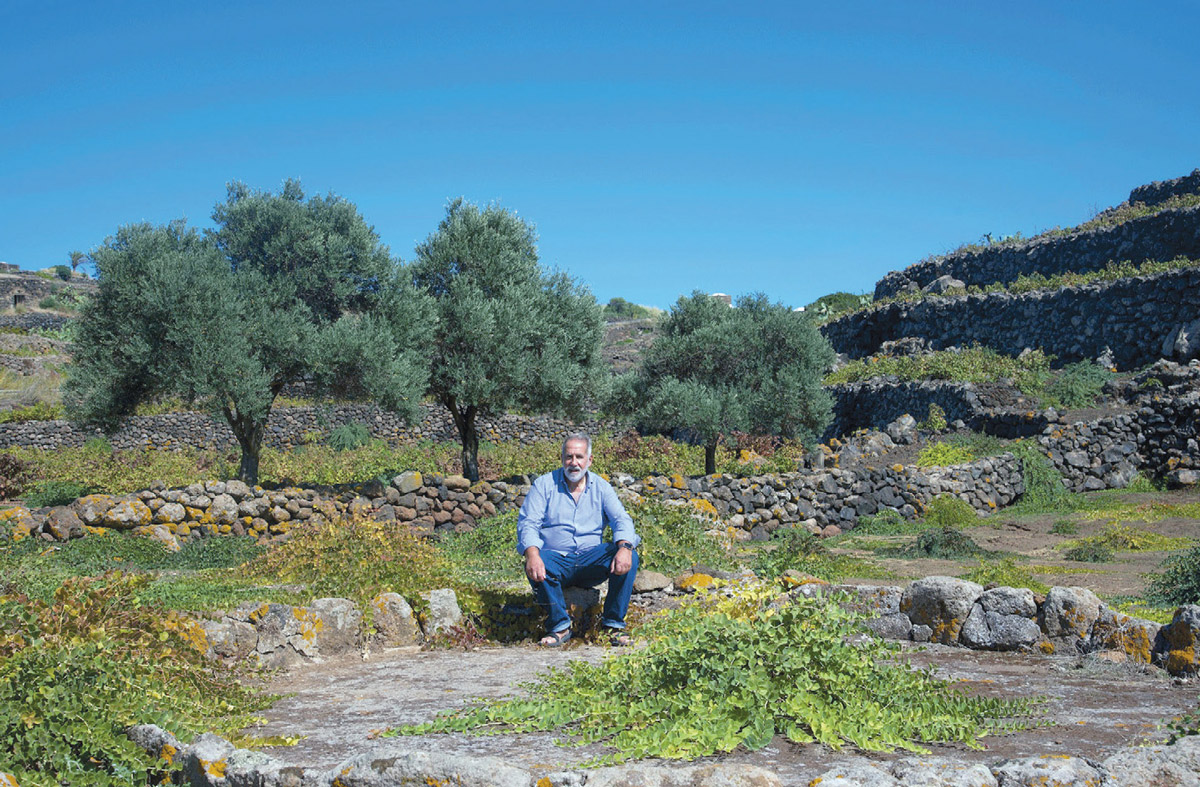John Savittieri: The Man Who Loves Capers
Most visitors to Italy travel to Rome, Venice, Capri, and other popular tourist sites. John Savittieri of Maple-wood took the road less traveled to the tiny Sicilian island of Pantelleria, where he fell in love with a tiny edible flower bud and his life path bloomed into a new career.
Capparis spinosa plants grow wild across the island, their large white flowers growing on prickly stems. But the buds of undeveloped flowers are capers, and once cured and pickled, they are prized worldwide for their briny, tangy seasoning.
Savittieri is now working to bring the world’s best capers to the United States.
The path to capers
A New Jersey native, Savittieri has Italian roots and, like many children of Italian descent, grew up immersed in culinary traditions. His father was a butcher and owned a deli; Savittieri also spent much childhood time with his grandparents. “My grandmother was a fantastic cook. Food was all around me. But it’s like ‘cut your own wake’—and I became a furniture maker.”
In the late 1970s, he studied woodworking at the Peters Valley School of Craft in Sussex County, then took his skills to Manhattan, where he worked for Abitare, an Italian furniture company that was “an explosion of Italian design.” He worked with and was influenced by many leading designers, including Pino Pedano from Milan.
“I developed a technique where I would produce furniture with the same sensibility as the Italian designers, with stone details, woodworking, metalworking,” Savittieri says. “I was a pretty popular guy in the ’80s and ’90s,” designing both residential and commercial custom furniture for trendy New York City clients.
When Savittieri eventually retired, he began to explore his Italian heritage. It began with a television episode featuring Anthony Bourdain visiting Sicily, with a stop in Pantelleria, close to the coast of Africa. Savittieri planned a trip.
“It’s a little island, a volcano outcropping where they grow capers. There are no beaches—it’s nothing like Capri—but it was kind of exotic and lonely and off the beaten track, and it appealed to my sensibilities,” he says.
Savittieri spent several weeks in an Airbnb “soaking it all up” and became friends with the owner, who taught him much about the arid island. Savittieri enjoyed great meals, and visited historic dammusi—small homes made of volcanic stone with curved roofs to collect rainwater for drinking. Today, drinking water is delivered to the island by ship twice a day.
Savittieri’s personal epiphany came during a visit to Pantelleria’s agricultural co-op, where capers that are handpicked early each morning at small local farms are sorted by size. “And there I had the idea for a business,” he says. “I’m retired, but in this day and age you need an extra source of income to stay alive—and capers are gaining popularity in the United States.”

The difference that made a difference
The most important part of Savittieri’s business is educating the public about capers—and why Pantelleria’s capers are considered among the best.
Capers are the bud of the plant’s flower; if left unpicked, an exotic white and purple flower blooms. Capers are too bitter to be eaten raw. Most Americans are familiar with capers from Turkey or Spain that are pickled in brine water or vinegar, Savittieri says.
In Pantelleria, where water is too precious to make brine, capers are preserved with unrefined Trapani sea salt, naturally evaporated from the Sicilian Sea.
Pantelleria capers are considered the best in the world by many food connoisseurs, says Savittieri, who sells only the “piccolo” tiny capers because “they are the best.” He also sells caper berries, which are the oblong-shaped fruit of the caper bush that appear from the buds remaining on the bush after the small unopened buds have been picked. Caper berries are gaining popularity among bartenders, who use them as a delectable alternative to the olive in a dry martini.
Growing a business
The process of importing foods from Italy is quite different than crafting designer furniture for wealthy clients. With help from his friend Fillippo in Pantelleria, Savittieri learned how to import products in bulk. He started with packages but as orders increase he plans to expand to pallets.
“When I was growing up, Italian heritage wasn’t well received. Now there’s a whole explosion of Italian food and culture,” Savittieri says. Capers enrich the flavor of meats, seafood, pasta, rice, and vegetables. They are key ingredients in chicken piccata and bruschetta, an enhancement for salmon filets, and atop smoked salmon on bagels.
Among his other products imported from Pantelleria, under the name of A&J Savittieri, are oregano, rosemary, and fennel seeds. Supermarket oregano in the United States “is a muddy green color, while Pantelleria oregano is flaky and bright green, beautiful and very delicious because of the volcanic soil and climate conditions,” he says. “It’s amazing.”
Savittieri sells his products individually and also in an oval wood gift box silkscreened with his company logo. It holds packages of Pantelleria capers, caper berries, rosemary, oregano, Trapani salt, and a small ceramic dammuso house to store the capers. “You keep it in your kitchen. You rinse the salt off the amount of capers you want to use, and keep the remainder in olive oil.”
- For details, visit eatcapers.com.
THE TINY BUDS OF UNDEVELOPED FLOWERS ARE CAPERS, AND ONCE CURED AND PICKLED, THEY ARE PRIZED WORLDWIDE FOR THEIR BRINY, TANGY SEASONING.





